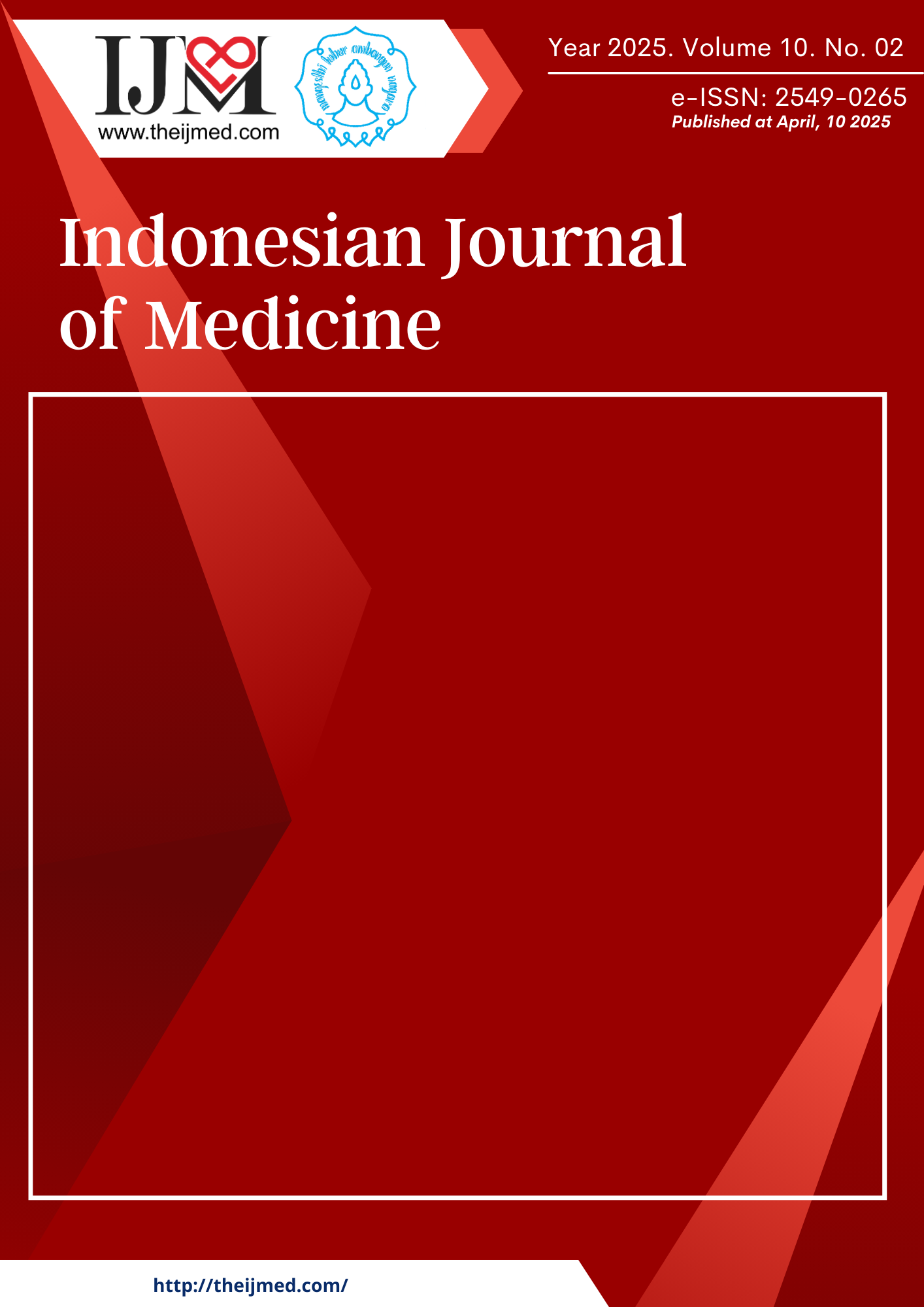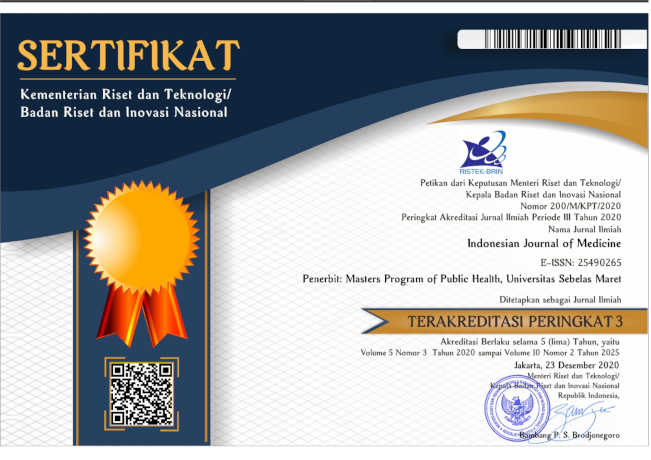The Application of the Health Belief Model in the Selection of Acupuncture Therapy for Low Back Pain Patients
DOI:
https://doi.org/10.26911/theijmed.2025.10.2.844Abstract
Background: Low back pain (LBP) is one of the health problems experienced by 50–80% of adults. LBP affects individual, physical, social, and psychological aspects. Individuals suffering from LBP require comprehensive treatment to ensure the success of therapy. The study aims to determine the patient's perception of the choice of LBP therapy using the Health Belief Model theory.
Subjects and Method: This research was conducted using a cross-sectional study conducted in Surakarta, from September to October 2024. A total of 200 acupuncture patients and physiotherapy patients were selected using fixed disease sampling. The independent variables were vulnerability perception, severity perception, benefit perception, obstacle perception, cues to action perception, self-efficacy. The bound variable is the choice of therapy. The data using questionnaires were analyzed using multiple logistic regression.
Results: Perceived susceptibility was less likely to use acupuncture therapy (OR= 0.51; 95% CI= 0.14 to 1.79; p=0.293). Perceived severity was more likely to use acupuncture therapy (OR=3.99; 95% CI= 1.17 to 13.54; p= 0.027). Perceived benefits were more likely to use acupuncture therapy (OR=43.90; 95% CI= 9.45 to 203.99; p<0.001). Perceived barriers were less likely to use acupuncture therapy (OR=0.03; 95% CI p< 0.01 to 0.20; p< 0.001). Cues to action were more likely to use acupuncture therapy (OR=7.10; 95% CI p= 2.20 to 22.91; p< 0.001). High self-efficacy has a greater likelihood of using acupuncture therapy (OR=142.49; 95% CI= 14.17 to 1432.86; p<0.001).
Conclusion: The Health Belief Model for the selection of acupuncture therapy increased with the perception of severity, perception of benefits, action signals, and self-efficacy. The choice of acupuncture therapy decreased with a high perception of resistance. Perception of vulnerability was statistically not significantly associated with therapy selection. The independent variables in the model were able to explain the variation in therapy selection (acupuncture vs physiotherapy) by 68.69%.
Keywords:
acupuncture, Health belief model, HBM, low back painReferences
Aghdash S, Mohseni M, Etemadi M, Royani S, Moosavi A, Nakhaee M (2015). Prevalence and cause of self-medication in Iran: a systematic review and meta-analysis article. Iran J Public Health. 44(12):1580–1593. PMID: 26811809.
Arye E, Lopez G, Rassouli M, Ortiz M, Cramer H, Samuels N (2024). Cross-cultural patient counseling and com-munication in the integrative medicine setting: respecting the patient’s health belief model of care. Curr Psychiatry Rep. 26:1–13. doi:10.1007/s11920-024-01515-2.
Bento TPF, dos-Santos-Genebra CV, Maciel NM, Cornelio GP, Simeão SFA, de Vitta A (2020). Low back pain and some associated factors: is there any difference between genders? Braz J Phys Ther. 24(1):79–87. doi: 10.1016/j.bjpt.2019.01.012.
Dempster NR, Wildman BG, Masterson TL, Omlor GJ (2018). Understanding treatment adherence with the health belief model in children with cystic fibrosis. Health Educ Behav. 45(3): 435–443. doi: 10.1177/109019811-7736346.
Fatoye F, Gebrye T, Odeyemi I (2019). Real-world incidence and prevalence of low back pain using routinely collected data. Rheumatol Int. 39(4):619–626. doi:10.1007/s00296-019-04273-0.
Knezevic NN, Candido KD, Vlaeyen JWS, Van Zundert J (2021). Low back pain. Lancet. 398(10294):78–92. doi: 10.1016/S0140-6736(21)00733-9.
Lee C, Duffy SA, Louzon SA, Waltje AH, Ronis DL, Redman RW, Kao TS (2014). The impact of Sun Solutions educational interventions on select health belief model constructs. Work-place Health Saf. 62(2):70–79. doi: 10.1177/216507991406200204.
Loke AY, Davies L, Li SF (2015). Factors influencing the decision that women make on their mode of delivery: the health belief model. BMC Health Serv Res. 15:274. doi:10.1186/s12913-015-0931-z.
MacArthur KR (2017). Beyond health beliefs: the role of trust in the HPV vaccine decision-making process among American college students. Health Sociol Rev. 26(3):321–338. doi: 10.1080/14461242.2017.1381035.
Mathijssen EGE, vanden-Bemt BJF, van den Hoogen FHJ, Popa CD, Vriezekolk JE (2020). Interventions to support shared decision making for medication therapy in long-term conditions: a systematic review. Patient Educ Couns. 103(2):254–265. doi: 10.1016/j.pec.2019.08.027.
Nieminen LK, Pyysalo LM, Kankaanpää MJ (2021). Prognostic factors for pain chronicity in low back pain: a systematic review. Pain Rep. 6(1):e919. doi: 10.1097/PR9.00000-00000000919.
Parwati NM, Bakta IM, Januraga PP, Wirawan IMA (2021). A health belief model-based motivational interview-ing for medication adherence and treatment success in pulmonary tuberculosis patients. Int J Environ Res Public Health. 18(24):13238. doi: 10.3390/ijerph182413238.
Zhang X (2018). Application of discrete event simulation in health care: a systematic review. BMC Health Serv Res. 18(1):687. doi:10.1186/s12913-018-3456-4.











